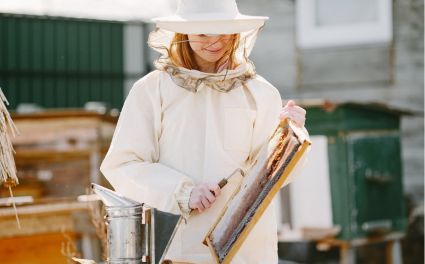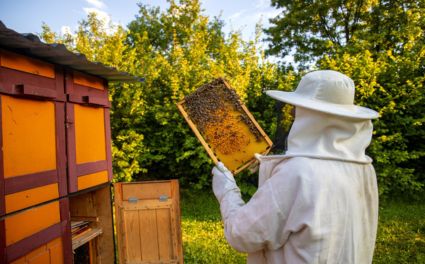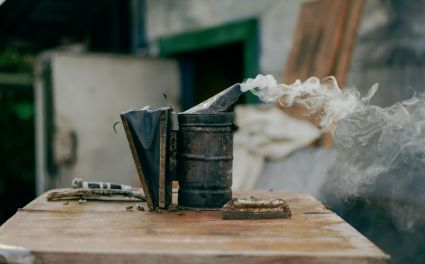Keeping your beekeeping gear clean is more than just about appearance — it’s about safety, comfort, and hive health. Over time, beekeeping suits and beekeeping jackets can collect dirt, pollen, honey, and propolis, all of which can affect breathability, durability, and protection.
In this guide, you’ll learn the best methods for cleaning, drying, and maintaining your beekeeping apparel to ensure long-lasting use. These simple but effective practices can make your gear last years longer — saving you time, money, and unnecessary discomfort during inspections.
Why Regular Washing Matters in Beekeeping
Keeping You and Your Bees Healthy
A clean suit isn’t just about staying fresh — it’s about preventing the spread of diseases and pests between hives. Contaminants like wax, propolis, and pollen can harbor bacteria or mites, putting your colony at risk. Regular cleaning keeps both your gear and your bees in top condition.
Preserving Suit Quality
Residue buildup can damage fabric fibers over time. Washing your suit properly maintains its strength and flexibility, preventing premature wear and tear. Whether it’s a beekeeping jackets or a full suit, regular care ensures consistent protection against stings.

How to Wash a Beekeeping Suit or Jacket
Step 1: Pre-Wash Preparation
Before you start, remove any visible stingers or debris. A soft brush works well for dusting off dried wax or dirt. Make sure all zippers are closed and Velcro straps secured — this prevents damage during washing.
Step 2: Choosing the Right Detergent and Temperature
Use a mild detergent that’s free of harsh chemicals. Strong cleaners can weaken the mesh or cotton material. Stick with cold or lukewarm water, as hot water can shrink or distort the fabric.
Step 3: Machine Wash or Hand Wash?
Most beekeeping suits can handle a gentle machine wash, but check the care label first. For delicate or older suits, hand washing is safer.
-
Machine Wash: Use a gentle or delicate cycle, cold water, and skip the fabric softener.
-
Hand Wash: Use a bathtub or large basin, gently agitating the suit with mild detergent. Rinse thoroughly to remove all residue.
Fabric softeners can leave a coating that reduces breathability and sting protection — it’s best to avoid them entirely.
Removing Stains and Odors Naturally
Propolis Stains
Propolis is notoriously sticky, but you can remove it easily with this method:
-
Freeze the suit in a plastic bag for a few hours.
-
Once hardened, gently scrape off the propolis using a dull knife or spoon.
-
Dab the stained area with rubbing alcohol or isopropyl solution.
-
Rinse and wash as usual.
Honey and Pollen Stains
These are common after honey extractions or hive inspections. Mix equal parts of water and vinegar or make a baking soda paste. Apply to the stain, let sit for 15–20 minutes, then gently scrub and rinse.
Sweat and Odor Removal
For lingering odors, soak the suit in a solution of baking soda and water for 1–2 hours. When rinsing, add a cup of white vinegar — it neutralizes odors and acts as a natural disinfectant.
If you use beekeeping gloves made of leather or mesh, clean them separately by wiping them with a damp cloth and mild soap, then air dry. Avoid soaking gloves entirely to maintain flexibility.
The Best Way to Dry a Beekeeping Suit
Air Drying is Key
Heat can weaken elastic bands and shrink cotton fibers. The best method is air drying in a shaded, well-ventilated area. Avoid hanging your suit in direct sunlight, as prolonged UV exposure fades colors and reduces fabric integrity.
A clothesline or drying rack works perfectly. If your suit includes a beekeeping veils, reshape it gently while drying to preserve its structure.
How to Store Your Beekeeping Gear
Once clean and completely dry, proper storage is essential to maintain freshness and longevity.
-
Store in a cool, dry place, away from humidity or direct sunlight.
-
Use breathable garment bags to prevent mildew.
-
Keep tools and suits separate — sharp tools can puncture mesh or fabric.
For your accessories, store your beekeeping trousers neatly folded and your veils protected in individual pouches. If you use beekeeping ankle protection, keep them with your boots to prevent loss.
Extending Suit Life Through Regular Maintenance
Inspect Before and After Each Use
Always check your suit for tears, worn seams, or faulty zippers. Small repairs can save you from replacing the entire garment later. A quick stitch or patch can go a long way in preserving sting protection.
Maintain Your Beekeeping Equipment Too
Your gear is just as important as your apparel. Clean Beekeeping Equipments like smokers, hive tools, and scrapers regularly to avoid disease spread. Residue-free tools support hive hygiene and improve productivity.
Keep It Fresh
To keep your suit smelling pleasant, add natural scent boosters like lavender sachets or cedar wood chips in your storage bag. Avoid artificial sprays or strong chemicals, as they can irritate bees.
Caring for Specialty and Kids’ Suits
Young beekeepers need just as much protection as adults. Beekeeping kids suits require similar washing care — gentle detergent, cold water, and air drying. Their smaller size makes them easier to hand wash and maintain.
For more advanced protection, consider breathable mesh options or full-coverage designs available in the OZ Armour kids’ range.
And for those who love adding a touch of style to their apiary, pink bee suits bring color to your work without compromising safety or comfort.
Expert Tips for Long-Lasting Beekeeping Apparel
-
Avoid Bleach: It weakens fibers and fades color.
-
Use Zipper Protectors: When washing, cover zippers with a cloth to prevent snagging.
-
Repair Early: Don’t ignore small tears; reinforce seams before they widen.
-
Rotate Your Gear: Having two suits allows you to alternate and extend each one’s lifespan.
-
Inspect Before Every Hive Visit: A single unzipped flap or worn cuff can mean a sting.
OZ Armour’s craftsmanship ensures their beekeeping suits and jackets withstand years of use when properly maintained.
Why Choosing Quality Gear Matters
Your comfort and safety rely on good equipment. High-quality materials make washing and maintenance easier while ensuring continued sting protection.
OZ Armour designs their gear with premium breathable fabrics, reinforced stitching, and rust-resistant zippers — allowing every beekeeper to work confidently through all seasons. From jackets to veils and ankle protection, each product is built for reliability and ease of care.
Explore the full line of durable, washable apparel through their collection of beekeeping suits.

Learn More and Keep Improving
The more you understand your gear, the better you care for it — and the longer it lasts. OZ Armour provides a variety of educational resources to help beekeepers build strong practices.
-
Visit Learn Beekeeping for expert guides and maintenance tutorials.
-
Read more blogs about beekeeping to explore advanced care, hive management, and seasonal advice.
You can also upgrade your setup with their high-quality tools and accessories, designed to work seamlessly with your protective gear.
Final Thoughts
Washing your beekeeping suit or jacket the right way is a small step that makes a big difference. Regular cleaning, careful drying, and proper storage will keep your gear performing at its best — ensuring your comfort and your bees’ health.
OZ Armour’s globally trusted designs make maintenance easy. Their gear combines durability, ventilation, and flexibility — so whether you’re cleaning your first suit or maintaining a full collection, you can do it with confidence.
Clean gear means happy bees — and a safer, more enjoyable beekeeping experience every time you step into your apiary.




